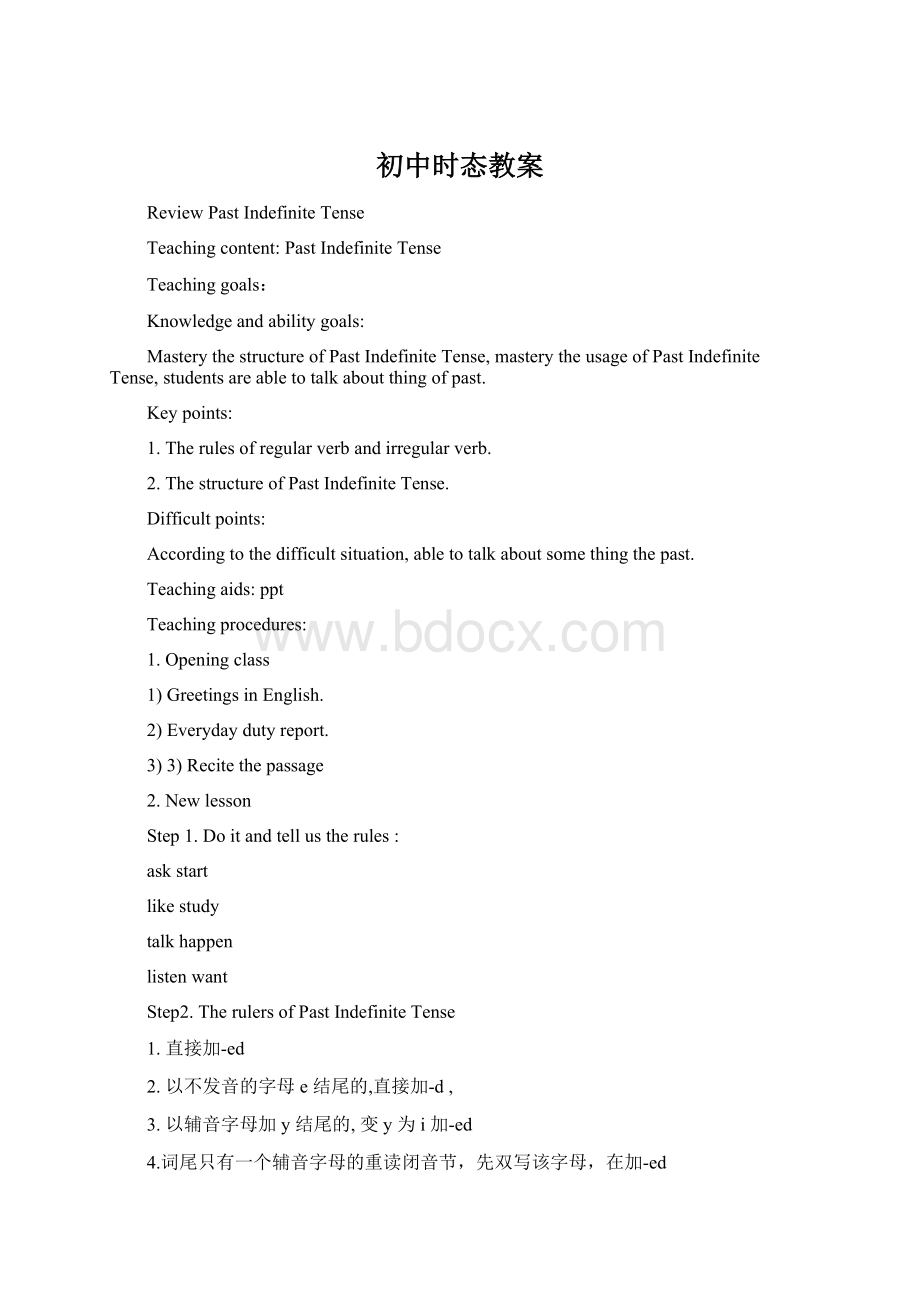初中时态教案文档格式.docx
《初中时态教案文档格式.docx》由会员分享,可在线阅读,更多相关《初中时态教案文档格式.docx(9页珍藏版)》请在冰豆网上搜索。

askstart
likestudy
talkhappen
listenwant
Step2.TherulersofPastIndefiniteTense
1.直接加-ed
2.以不发音的字母e结尾的,直接加-d,
3.以辅音字母加y结尾的,变y为i加-ed
4.词尾只有一个辅音字母的重读闭音节,先双写该字母,在加-ed
有些动词过去式的变化是不规则的,例如:
do/does–didam/is–wasare–werehave/has–had
buy–bought
Step3.Doexercise
seemake
leaverun
readsing
comedrink
getsay
flywrite
fallbreak
goeat
takehave
Step4.TheusageofPastIndefiniteTense
1、表示过去某个时间发生的动作或存在的状态。
Hewashereyesterday.
Igotupatsixthirtyyesterdaymorning.
Myfatherwasatworkyesterdayafternoon.
Didyouhaveagoodtimelastsummer?
2、表示过去经常或反复发生的动作。
Myfatheroftenwenttoworkbybuslastyear.
WhenIwasachild,Ioftenlistenedtomusic.
3.Be动词在一般过去时中的变化:
⑴am和is在一般过去时中变为was。
(wasnot=wasn'
t)
⑵are在一般过去时中变为were。
(werenot=weren'
⑶带有was或were的句子,其否定、疑问的变化和is,am,are一样,即否定句在was或were后加not,一般疑问句把was或were调到句首。
4.句中没有be动词的一般过去时的句子
否定句:
didn‘t+动词原形,
如:
Jimwenthomeyesterday.
Jimdidn'
tgohomeyesterday.
一般疑问句:
在句首加did,句子中的动词过去式变回原形。
DidJimgohomeyesterday?
特殊疑问句:
⑴疑问词+一般疑问句?
WhatdidJimdoyesterday?
Step5.Text
(1).Exercise.
1.She________(eat)noodlesforbreakfasteveryday..
2.LastyearIwanted__________(ride)abike,butit
_______(be)toohard.
3.Hismother________(buy)himanewbikelastmonth.
4.She___________(help)Jimfindhispenandhethankedherverymuch.
5.He_____________(watch)TVeveryday,but
he______________(notwatch)yesterday.
6._______Danny_______(hurt)hisarmyesterday?
(2).句型变换:
1.Iwashappy.__________happy?
Yes,I_______.
2.Theywereloud.___________loud?
No,they_______.
3.Jimwenttoschoolyesterday.
_______Jim_______toschoolyesterday?
Yes,he______.
4.Hewentshoppinglastweek.
He____________shoppinglastweek.
(3).改写句子:
1、Lucydidherhomeworkathome.(改否定句)
Lucy______________herhomeworkathome.
2、Hefoundsomemeatinthefridge.(变一般疑问句)
______he___________meatinthefridge?
3、Shestayedthereforaweek.(对划线部分提问)
_________________she_____there?
4、Therewassomeorangeinthecup.(变一般疑问句)
_____there_____orangeinthecup?
Homework:
1,Finishtheactivitybook
2.understandthePastIndefiniteTense
Feedback:
TheSimpleFutureTense
TheSimpleFutureTense
MasterythestructureofTheSimpleFutureTense,masterytheusageofTheSimpleFutureTense,studentsareabletotalkaboutthingoffuture..
1.ThestructureofTheSimpleFutureTense
Accordingtothedifficultsituation,abletotalkaboutsomethingthefuture.
Step1.TherulersoftheSimpleFutureTense
will引导的一般将来时:
表示将来发生的动作或存在的状态,最基本的结构:
will+动词原形
“主谓(宾)句型”的一般将来时:
肯定句:
主语+will+动词原形+(宾语)+其他
Somedaypeoplewillgotothemoon.
在will的后面加not即可。
willnot可缩写为won’t
Theywon’tusebooks.
把will提到句子主语之前,结尾变问号。
Willstudentsgotoschoolinthefuture?
特殊疑问句:
特殊疑问词+will+主语+动词原形+其他?
Whatwillyourdreamschoolhave?
Step2.TheusageoftheSimpleFutureTense.
1、表示将来某一时刻的动作或状态:
Wewillcometoseeyouthedayaftertomorrow.
Therewillbeawonderfulshownextweek.
2、表示将来某一段时间内经常的动作或状态:
Thestudentswillcomeandworkinthelabonceaweek.
Wewillcomeandworkinthisfactoryeveryyear.
Step3.一般将来时两种基本句式的区别:
在初中阶段来讲,”begoingto+动词原形”和“will+动词原形”这两种表示将来时态的结构没什么区别。
但在现代英语中,特别是在口语中,表示将来时多用“begoingto+动词原形”这一形式。
另外他们主要区别在于“begoingto+动词原形”表示一个事先考虑好的意图,相当于“打算、计划、准备”,而will则表示未经事先考虑的意图。
Step4.Text
1.Ihopethatyou__agoodtimethisevening.
A.haveB.arehavingC.willhaveD.has
2.Lookatthosebigblackclouds.It__rain.Let`shurry.
A.mustB.willC.wouldD.isgoingto
注意:
will与begoingto的区别,begoingto可以表示明显将要发生的情况.
3.There__abasketballmatchthisafternoon.
A.willhaveB.willbeC.hasD.have
4.We__totheparkifitisfinetomorrow.
A.willgoB.goC.goesD.togo
用所给词的适当形式填空:
1.There__(be)anAmericanfilmnextweek.
2.They__(finish)theworkthisafternoon.
3.Tom__(play)footballwithustomorrow?
4.Robots__(do)lotsofworkinourhomesinthefuture.
5.There__(be)strongwindstonight.
6.Beforelong,he__(forget)allaboutthematter.
7.He__(be)backinthreehours.
8.We__(send)foradoctorifyou__(be)notbetterintheevening.
1.明天不用上课。
There____________classtomorrow.
2.也许在100年后人们将活到200岁。
_____people_______________200yearsold
____100years.
3.许多女孩子喜欢养宠物。
Manygirlslike______apet.
4.Therewillbeasportsmeetingtomorrow.(一般疑问句)
_________asportsmeetingtomorrow?
5.我想将会有更多高楼,更少汽车,更少污染。
Ithinktherewillbe____tallbuildings,___cars,___
pollution.
6.你认为Sally5年后会成为什么?
What_________Sally______in5years?
2.understandtheSimpleFutureTense
ThePresentContinuous
ThePresentContinuous
MasterythestructureofThePresentContinuous,masterytheusageofThePresentContinuous,studentsareabletotalkaboutthingofpresent.
1.ThestructureofThePresentContinuous
Accordingtothedifficultsituation,abletotalkaboutsomethingthepresent.
2.Newlesson.
eatstop
swimbegin
skiget
danceshop
Step2.TherulersofthePresentContinuous
1.大多数动词可在动词后直接加-ing。
eat-eating,do-doing,read-reading
2.如果动词以-e结尾,则去掉-e,再加-ing。
come-coming,have-having,
make-making,write-writing
3.如果动词有两个音节,且重音在第二个音节上,则末尾的辅音字母须双写,再加-ing。
forget-forgetting
4.以-ic结尾的动词,应先把-ic变为-ick,再加-ing,eg。
picnic-picnicking
5,特殊变化要记住.
lie-lying,die-dying,tie-tying
Step3.TheusageofthePresentContinuous
1.表示现在(指说话人说话时)正在发生的事情或动作.
2.表示现阶段一段时间内在做的事,此刻动作不一定正在进行。
3.现在进行时也可以表示将要发生的动作
1.一般疑问句及回答
be(am/is/are)+主语+doing+其他成分
AmIsinging?
Yes,youare.No,youaren’t.
Aretheywriting?
Yes,theyare.No,theyaren’t.
2.特殊疑问句及回答
特殊疑问词+be(am/is/are)+主语+doing+其他成分
Whatareyoudoing?
Weareplaying.
(要求就提问内容具体回答).
Step4:
现在进行时的标志
1.一般情况下,句首或句末出现now。
2.句首有表示具体时间的句子。
3.句首出现look或者listen.
4.还有一些句子,需要凭自己的语感。
1.We___________(play)footballnow.
2.Look!
Thesebutterflies_________(fly)inthesky.
3.Listen!
Thegirl___________(sing)inthenextroom.
4.It’s
5
o’clocknow.We__________(have)suppernow.
5.JackandKetty______________in
thelake.Let’sjointhem.(swim)
2.understandthePresentContinuous.